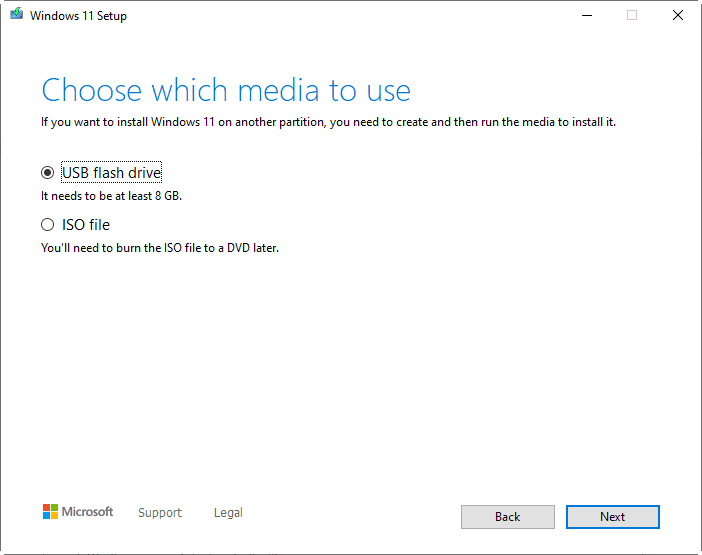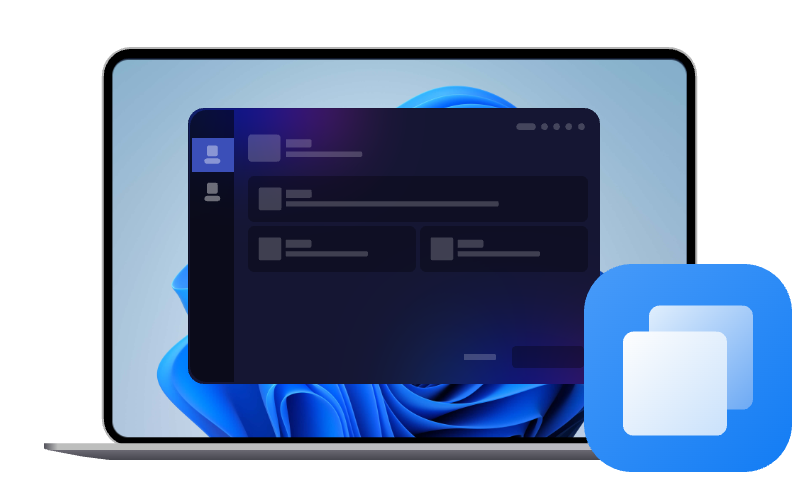Windows 11 Upgrade VS Clean Install: Differences & Which to Choose?
On this page, we will present Windows 11 upgrade vs clean install, the advantages and disadvantages of each, and how to choose. Hope it can help you!
With Microsoft announcing that Windows 10's end of support comes on October 14, 2025, many users may have to upgrade to Windows 11. At this time, you might be torn between two options: in-place upgrade or fresh install. While both methods will ultimately result in a Windows 11 upgrade, the method you choose may affect your system's performance, stability, and even the retention of your personal files and programs.
If you're not sure whether a Windows 11 upgrade vs. clean install is best for your needs, this guide provides detailed information.
Windows 11 Upgrade vs. Clean Install - What's the Difference?
In the following, we will break down Windows 11 clean install vs. upgrade, how they differ, their respective pros and cons, and the situations in which to use each.
Windows 11 Upgrade: Keep Your Files and Settings
An in-place upgrade installs Windows 11 on top of your existing Windows 10 system. It retains all your personal files, installed programs, settings, and drivers. It’s the more convenient route, requiring minimal technical know-how and less time.
Here's what the upgrade path offers:
- Keeps apps, files, and preferences intact.
- No need to reinstall drivers or third-party software.
- Ideal for users who want minimal disruption.
However, upgrades may leave behind old system garbage, registry errors, or compatibility issues. These residual issues may cause slow performance or unexpected bugs.
Clean Install: A Fresh Start
A clean install, on the other hand, completely wipes out your system drive and installs Windows 11 from scratch. This method doesn’t preserve files or apps unless you back them up manually. It’s a fresh start, ideal for users who want a streamlined, tidy system.
What you get with a clean install:
- A completely new operating system environment that eliminates any old components.
- Optimal system performance and improved stability.
- Best for older computers or systems with slow-running or corrupted software.
Of course, the downside is that you'll need to reinstall your system, all your software, and lose your files. But if you are looking for speed, cleanliness, and long-term reliability, a clean install might be what you need.
|
|
Advantages |
Disadvantages |
Recommended When |
|
Windows 11 Upgrade |
- Very beginner-friendly. - Keeps all data, apps, and settings intact. - Faster and easier process. - No reinstallation needed. |
- May retain system clutter and bugs. - Possible software conflicts. - System runs not as fast as a clean install in the long run. |
- You want a quick and easy upgrade. - Systems are already running smoothly. - Avoiding the hassle of reinstalling programs. |
|
Clean Install |
- Provides a fresh, clean system. - Removes bugs, bloatware, and malware. - Enhances speed and stability. |
- Requires specific tech knowledge. - Requires reinstalling apps and restoring files. - More time-consuming. - Risk of data loss without backup. |
- You're experiencing performance issues and want optimal system performance. - PCs with malware, bugs, or registry issues. - Fresh starts and new hardware setups. |
The choice between Windows 11 upgrade vs. clean install really comes down to your current system's health and your comfort level with reinstalling everything. After understanding the differences between clean install vs. upgrade Windows 11, let's now look at how to upgrade to Windows 11 using each of them now.
How to Upgrade to Windows 11 with In-Place Upgrade
Upgrading is straightforward and doesn't require bootable media or complicated BIOS settings. Here is how to get it done.
- Notes: To perform an in-place upgrade to Windows 11, you need to make sure:
- You are running Windows 10 version 2004 or later.
- There is enough free space for Windows 11 download, ideally 20 GB or more.
- You must upgrade to the same edition (e.g., Home to Home, Pro to Pro)
- Your device must meet Microsoft's official minimum system requirements for Windows 11.
Step 1. Download and run Microsoft’s PC Health Check tool to ensure your device meets Windows 11 requirements.
Step 2. Go to Microsoft’s official website and download the Windows 11 Installation Assistant.
Step 3. Run the .exe tool and click Accept and install. It will start to install Windows 11 while keeping your current files and settings.
Step 4. Once installation is complete, the utility will ask you to restart your PC to finish the installation of Windows 11. Click Restart Now.
Step 5. Your system will reboot into Windows 11. Perform a quick configuration and you’re good to go.
How to Upgrade to Windows 11 via Clean Install
For a completely fresh system, you’ll want to do a clean install. This involves wiping your primary disk and installing Windows 11 using a bootable USB drive.
- Notes:✎...
- Please backup your important files on the computer in advance. The clean install will wipe out your hard drive and start from scratch.
- You will need a USB drive with at least 8GB capacity.
- Unplug unnecessary devices to make sure that your computer boots from the bootable USB drive correctly.
Step 1. Insert the USB flash drive into computer. Download the Windows 11 Media Creation Tool and launch it by clicking Download Now under Create Windows 11 Installation Media.
Step 2. Select the USB flash drive option, and follow the on-screen instructions to create a bootable USB drive.
Step 3. Restart your PC and enter BIOS/UEFI (usually by pressing F2, Del, or Esc). Change the boot order to prioritize the bootable USB drive.
Step 4. On boot, when the Windows Setup screen appears, click Install now to start the Windows 11 installation.
Step 5. Select an edition of Windows 11 and choose Custom: Install Windows only (advanced) when asked, and select your system drive to format and install Windows 11 fresh.
Step 6. After installation, you’ll set up your Microsoft account, preferences, and reinstall your applications.
Bonus Tip: Best Way to Copy Windows System
Whether you choose a Windows 10 to 11 upgrade or a clean install, it is recommended to make a full backup of your system beforehand. This not only protects your files, but also gives you the option to revert if something goes wrong. This is where AOMEI Cloner comes into play.

- Its Disk Clone allows copying everything on the old disk to another disk, including all the system-related partitions and non-system data partitions.
- Its System Clone can help you transfer only Windows OS to another drive instead of the entire disk.
- Its Partition Clone enables you to copy a specific partition to another drive.
- It is also capable of creating bootable USB or CD/DVD to boot your computer into WinPE and perform offline data clone.
You can copy your Windows system by downloading and running the AOMEI Cloner, selecting Clone > Disk Clone or System Clone to copy the entire system drive or only the Windows operating system, per your needs.
FAQs about Windows 11 Upgrade vs. Clean Install
#1. Is it better to upgrade to Windows 11 or do a clean install?
It depends on your situation. If you want a fast upgrade and don't want to reinstall apps or reconfigure settings, go with the upgrade. However, if you're facing performance issues or want to avoid old problems in the new OS, a clean install is the better choice.
#2. What is the difference between a clean installation and an upgrade?
An upgrade keeps all your files, settings, and apps intact. A clean installation wipes your drive and installs Windows fresh. The former is faster, but the latter offers a cleaner, more stable experience.
#3. Do I have to reinstall programs after Windows 11 upgrade?
No, a standard upgrade will retain all your applications and data. However, it’s always smart to back up everything beforehand, just in case something goes wrong during the process.
#4. Will I lose everything if I do a clean install of Windows 11?
Yes, unless you back up your files first. A clean install wipes the system drive completely. Always ensure your files are safely stored on another drive or cloud service before proceeding.
#5. Does a clean install of Windows improve performance?
Absolutely. A clean install eliminates leftover files, registry bloat, malware traces, and background processes from your old OS. It gives your system a fresh start and often results in noticeably faster boot times and better responsiveness.
The Verdict
When it comes to Windows 11 upgrade vs clean install, there's no universal best choice - only what's best for you.
- Choose an upgrade if you are satisfied with your system’s current performance and want to save time.
- Go with a clean install if you want to start fresh, boost performance, or resolve long-standing system issues.
No matter the path, preparation is important. Back up your files, check hardware compatibility, and use tools like AOMEI Cloner to copy your Windows OS or boot drive to another drive to make sure you can boot up your system when something unexpected happens. Also, you can use it to upgrade your C drive and other drives without losing anything.


